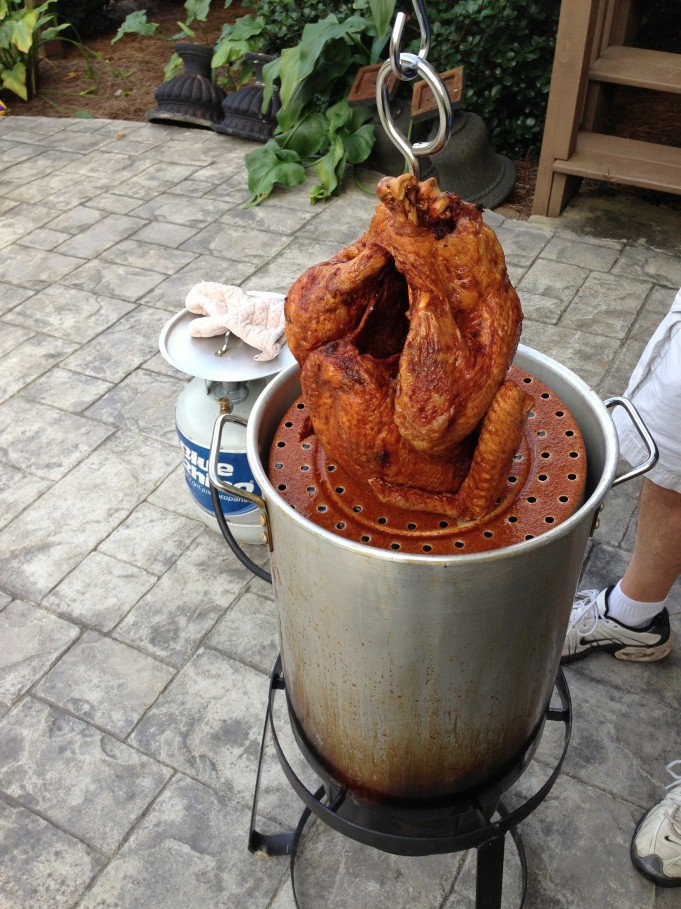
Deep-Fried Turkey
Larry and I have been deep frying turkeys for as long as we’ve been together and we take great pride in sharing this family tradition with others. Over the past 19 years, we’ve converted many of our Atlanta friends (who hail from all different parts of the country) from roast turkey to fried. And we delight in the fact that several have mastered this Cajun custom and adopted it as their own. The process is not complicated, but it can be risky if you don’t plan ahead and take the necessary precautions. Unfortunately, most of what you’ve read about deep-fried-turkey-related house fires and other major accidents is true. So cook with caution.
The best advice we can give you for successfully and safely frying a turkey is to invest in an outdoor turkey fryer kit. Each kit comes with the equipment needed to help maximize results and minimize accidents. We’re talking about, at a minimum, the right size pot (they’re tall and narrow so you use less oil and the bird cooks quicker and more evenly), a nifty poultry stand (to maneuver the big bird in and out of the hot oil) and a deep-fry thermometer (because you must monitor the temperature closely during the entire cooking process). Also make sure you follow the manufacturer’s instructions as well as these additional cooking tips:
- Set up the fryer kit in an open outdoor area on a sturdy, flat surface. Never use the deep fryer indoors, in a garage, under a carport or on a wooden deck.
- Avoid windy areas.
- Abort the entire gig if it’s raining or snowing hard.
- Keep the fryer away from bushes, low-hanging trees and power lines and other flammable items.
- Position the propane tank as far away from the burner as possible.
- Always determine the amount of oil needed before heating the oil (the best way to do this is explained in my recipe). This is crucial. If you put too much oil in the pot, when you add the turkey to the oil it will overflow and cause a fire.
- Make sure the turkey is fully thawed, the innards and any pop-up timers have been removed and the cavity and outer skin have been patted dry.
- Use a deep-fry thermometer to carefully monitor oil temperature. The oil can take up to an hour to heat and a consistent temperature of 365 degrees F must be maintained throughout the cooking process for the best results. Never allow the oil to reach the fire hazard zone or red zone, as indicated on most high-temp thermometers. Reduce heat immediately if oil begins to smoke.
- Once the oil gets hot, do not attempt to move the pot or the burner. The slightest shift can topple the pot of hot oil.
- If the oil overheats before the turkey is added, let the oil temperature come down to the recommended level before putting the bird in the pot (otherwise, you’ll end up with burnt turkey skin and raw turkey meat).
- Before lowering the turkey into the hot oil, turn off the propane and remove the thermometer from the rim of the pot. This will prevent any potential overflow from catching on fire and keep the thermometer from breaking. Relight the fire and reinsert the thermometer after the turkey is safely in the pot.
- Lower and remove the turkey slowly and carefully to avoid splatters and spills.
- Use heavy gloves or grilling mitts with high temperature resistance and preferably non-slip grips.
- Wear closed-toe shoes to avoid any splatter burns.
- Don’t wear your Sunday best when manning the fryer.
- Never leave the pot unattended.
- Keep children and pets away from the fryer before, during and after cooking.
- Just in case, keep a dry chemical or CO₂ fire (Class B) extinguisher nearby–never use water on oil or grease fires.
Deep-Fried Turkey Recipe
1 12-14 pound turkey, fully thawed if frozen and innards removed
1 16-ounce jar injectable marinade, with injector (I use Cajun Injector Creole Butter)
Peanut oil (3-5 gallons), for frying
Prepare turkey fryer in an open outdoor area on a sturdy, flat, nonflammable surface. Determine amount of oil needed to fill fryer (amount varies based on size of pot and bird). Place turkey in empty fryer and add enough cold water to just cover. There should be several inches of room between waterline and top of pot. Remove turkey from water, pat dry and transfer to a large rimmed baking sheet. With a piece of tape, mark waterline on outside of pot. Pour out water and thoroughly dry fryer. Fill fryer with oil to tape marker; remove tape. Preheat oil to 365 degrees F. Use a deep-fry thermometer to monitor temperature. Meanwhile, inject turkey all over with marinade (turkey can be injected a day or two ahead and refrigerated–just make sure you figure out how much oil you need before injecting the bird). Let sit at room temperature while oil heats. Once oil is hot (which can take up to an hour), place turkey on poultry rack included in fry kit, turn off propane (to avoid a fire if any oil were to spill over), hook handle on top of rack and slowly lower turkey into oil. Relight fire and fry for 3 1/2 minutes per pound while maintaining oil temperature of 365 degrees F (internal temperature of breast should be 150-155 degrees F). When done, turn off fire and slowly remove turkey from oil allowing excess oil to drip back into pot. Transfer to a large baking sheet. When cool enough to handle, take turkey off of rack and let rest 30 minutes before carving. Do not cover turkey with foil. Makes 10 servings.
Genêt



